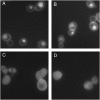Multiple functional domains of the yeast l,3-beta-glucan synthase subunit Fks1p revealed by quantitative phenotypic analysis of temperature-sensitive mutants
- PMID: 20124029
- PMCID: PMC2865904
- DOI: 10.1534/genetics.109.109892
Multiple functional domains of the yeast l,3-beta-glucan synthase subunit Fks1p revealed by quantitative phenotypic analysis of temperature-sensitive mutants
Erratum in
-
Multiple Functional Domains of the Yeast l,3-β-Glucan Synthase Subunit Fks1p Revealed by Quantitative Phenotypic Analysis of Temperature-Sensitive Mutants.Genetics. 2019 Jul;212(3):953. doi: 10.1534/genetics.119.302298. Genetics. 2019. PMID: 31292235 Free PMC article. No abstract available.
Abstract
The main filamentous structural component of the cell wall of the yeast Saccharomyces cerevisiae is 1,3-beta-glucan, which is synthesized by a plasma membrane-localized enzyme called 1,3-beta-glucan synthase (GS). Here we analyzed the quantitative cell morphology and biochemical properties of 10 different temperature-sensitive mutants of FKS1, a putative catalytic subunit of GS. To untangle their pleiotropic phenotypes, the mutants were classified into three functional groups. In the first group, mutants fail to synthesize 1,3-beta-glucan at the proper subcellular location, although GS activity is normal in vitro. In the second group, mutants have normal 1,3-beta-glucan content but are defective in polarized growth and endocytosis. In the third group, mutations in the putative catalytic domain of Fks1p result in a loss of the catalytic activity of GS. The differences among the three groups suggest that Fks1p consists of multiple domains that are required for cell wall construction and cellular morphogenesis.
Figures








Similar articles
-
Homologous subunits of 1,3-beta-glucan synthase are important for spore wall assembly in Saccharomyces cerevisiae.Eukaryot Cell. 2007 Feb;6(2):143-56. doi: 10.1128/EC.00200-06. Epub 2006 Dec 8. Eukaryot Cell. 2007. PMID: 17158736 Free PMC article.
-
Mutations in Fks1p affect the cell wall content of beta-1,3- and beta-1,6-glucan in Saccharomyces cerevisiae.Yeast. 2002 Jun 15;19(8):671-90. doi: 10.1002/yea.866. Yeast. 2002. PMID: 12185837
-
Topological and mutational analysis of Saccharomyces cerevisiae Fks1.Eukaryot Cell. 2012 Jul;11(7):952-60. doi: 10.1128/EC.00082-12. Epub 2012 May 11. Eukaryot Cell. 2012. PMID: 22581527 Free PMC article.
-
Up-regulation of the cell integrity pathway in saccharomyces cerevisiae suppresses temperature sensitivity of the pgs1Delta mutant.J Biol Chem. 2007 Jun 1;282(22):15946-53. doi: 10.1074/jbc.M701055200. Epub 2007 Apr 9. J Biol Chem. 2007. PMID: 17426021
-
Dissection of upstream regulatory components of the Rho1p effector, 1,3-beta-glucan synthase, in Saccharomyces cerevisiae.Genetics. 2002 Oct;162(2):663-76. doi: 10.1093/genetics/162.2.663. Genetics. 2002. PMID: 12399379 Free PMC article.
Cited by
-
High-content, image-based screening for drug targets in yeast.PLoS One. 2010 Apr 14;5(4):e10177. doi: 10.1371/journal.pone.0010177. PLoS One. 2010. PMID: 20418956 Free PMC article.
-
Discovery of a novel class of orally active antifungal beta-1,3-D-glucan synthase inhibitors.Antimicrob Agents Chemother. 2011 Nov;55(11):5099-106. doi: 10.1128/AAC.00432-11. Epub 2011 Aug 15. Antimicrob Agents Chemother. 2011. PMID: 21844320 Free PMC article.
-
CRS-MIS in Candida glabrata: sphingolipids modulate echinocandin-Fks interaction.Mol Microbiol. 2012 Oct;86(2):303-13. doi: 10.1111/j.1365-2958.2012.08194.x. Epub 2012 Aug 22. Mol Microbiol. 2012. PMID: 22909030 Free PMC article.
-
Global study of holistic morphological effectors in the budding yeast Saccharomyces cerevisiae.BMC Genomics. 2018 Feb 20;19(1):149. doi: 10.1186/s12864-018-4526-z. BMC Genomics. 2018. PMID: 29458326 Free PMC article.
-
Proteins involved in building, maintaining and remodeling of yeast cell walls.Curr Genet. 2013 Nov;59(4):171-85. doi: 10.1007/s00294-013-0403-0. Curr Genet. 2013. PMID: 23959528
References
-
- Abe, M., I. Nishida, M. Minemura, H. Qadota, Y. Seyama et al., 2001. Yeast 1,3-beta-glucan synthase activity is inhibited by phytosphingosine localized to the endoplasmic reticulum. J. Biol. Chem. 276 26923–26930. - PubMed
-
- Cabib, E., D. H. Roh, M. Schmidt, L. B. Crotti and A. Varma, 2001. The yeast cell wall and septum as paradigms of cell growth and morphogenesis. J. Biol. Chem. 276 19679–19682. - PubMed
-
- Cadwell, R. C., and G. F. Joyce, 1992. Randomization of genes by PCR mutagenesis. PCR Methods Appl. 2 28–33. - PubMed
Publication types
MeSH terms
Substances
LinkOut - more resources
Full Text Sources
Molecular Biology Databases

